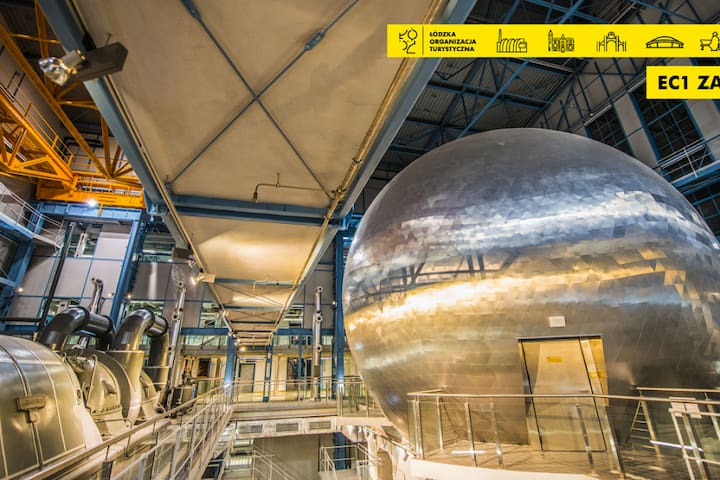Sightseeing
The Planetarium is one of the most modern and technically advanced spherical projection cinemas in all of Central Europe. The screen has a diameter of 14 metres and the camera will display images with a stunning resolution of 8K. Inside the theatre there will be space for 110 spectators.
11 Recomendado por los habitantes de la zona
Planetarium EC1
1 TargowaThe Planetarium is one of the most modern and technically advanced spherical projection cinemas in all of Central Europe. The screen has a diameter of 14 metres and the camera will display images with a stunning resolution of 8K. Inside the theatre there will be space for 110 spectators.
Opened in 1986 inside Karol Scheibler’s extraordinary 19th-century palace, the Cinematography Museum offers visitors two unique attractions in one. The museum itself offers a well-presented history of Polish cinema and takes plenty of hats off to the multitude of Polish film greats who studied in the city before going on to greater things, as well as numerous changing exhibitions.
20 Recomendado por los habitantes de la zona
Cinema museum Lodz
1 plac ZwycięstwaOpened in 1986 inside Karol Scheibler’s extraordinary 19th-century palace, the Cinematography Museum offers visitors two unique attractions in one. The museum itself offers a well-presented history of Polish cinema and takes plenty of hats off to the multitude of Polish film greats who studied in the city before going on to greater things, as well as numerous changing exhibitions.
The Promised Land
The first written record of a settlement here dates back to 1332, under the name Łódzia; 10 years later it was granted city rights by King Władysław Jagiello.
In 1820, state official Rajmund Rembieliński, who was interested in economic and urban expansion, set about redesigning the city's layout (which has since remained almost unchanged to this day), and crucially included transportation arteries. The city's cause was further aided when in 1825, statesman, philosopher and writer Stanisław Staszic started a campaign to turn Łódź into a centre of manufacturing. He drew the conclusion that Łódź was the perfect location to become a manufacturing hub, not least due to the numerous rivers and streams, which would provide water for the factories, but also for the abundance of timber from nearby forests.
The first cotton mill opened in 1825 and in 1839 the first steam-powered factory in Poland and Russia officially opened. Those who lived in the surrounding rural areas saw Łódź as a means to move away from the tough settings they were accustomed to, so much so that Łódź became known as a land of milk and honey. Polish author and Nobel laureate Władysław Reymont put it thusly in his famous late-19th century Łódź-based novel Ziemia Obiecana (The Promised Land): "For that 'promised land' – for that tumour – villages were deserted, forests died out, the land was depleted of its treasures, the rivers dried up, people were born. And it sucked everything into itself. And in its powerful jaws it crushed and chewed up people and things, sky and earth, in return giving useless millions to a handful of people, and hunger and hardship to the whole throng."
https://www.inyourpocket.com/
6 Recomendado por los habitantes de la zona
Łódź
The Promised Land
The first written record of a settlement here dates back to 1332, under the name Łódzia; 10 years later it was granted city rights by King Władysław Jagiello.
In 1820, state official Rajmund Rembieliński, who was interested in economic and urban expansion, set about redesigning the city's layout (which has since remained almost unchanged to this day), and crucially included transportation arteries. The city's cause was further aided when in 1825, statesman, philosopher and writer Stanisław Staszic started a campaign to turn Łódź into a centre of manufacturing. He drew the conclusion that Łódź was the perfect location to become a manufacturing hub, not least due to the numerous rivers and streams, which would provide water for the factories, but also for the abundance of timber from nearby forests.
The first cotton mill opened in 1825 and in 1839 the first steam-powered factory in Poland and Russia officially opened. Those who lived in the surrounding rural areas saw Łódź as a means to move away from the tough settings they were accustomed to, so much so that Łódź became known as a land of milk and honey. Polish author and Nobel laureate Władysław Reymont put it thusly in his famous late-19th century Łódź-based novel Ziemia Obiecana (The Promised Land): "For that 'promised land' – for that tumour – villages were deserted, forests died out, the land was depleted of its treasures, the rivers dried up, people were born. And it sucked everything into itself. And in its powerful jaws it crushed and chewed up people and things, sky and earth, in return giving useless millions to a handful of people, and hunger and hardship to the whole throng."
https://www.inyourpocket.com/
Sport events
Event and sports venue, Atlas Arena is one of the biggest facilities of its kind in Poland. It opened its doors in June 2009 and it offers comprehensive service for the organizers of both sports events and performances.
16 Recomendado por los habitantes de la zona
Atlas Arena
7 aleja ks. bp. Władysława BandurskiegoEvent and sports venue, Atlas Arena is one of the biggest facilities of its kind in Poland. It opened its doors in June 2009 and it offers comprehensive service for the organizers of both sports events and performances.



